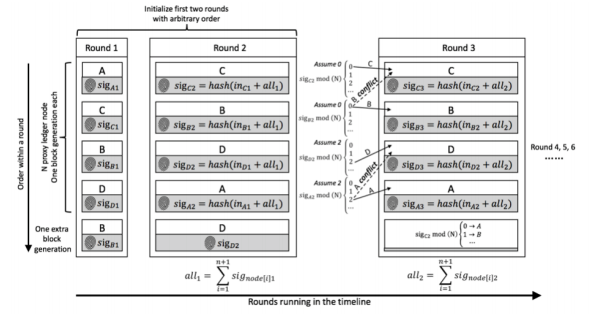Consensus
Overview
Consensus is crucial for blockchains as it decides which transactions are included in the block and their order. aelf's block formation mechanism is more complex than Bitcoin and Ethereum due to its need to record Side Chain data and its cloud-based service design. Miners must update info from multiple parallel Chains. aelf uses AEDPoS consensus for high-frequency and predictable block formation.
How aelf Consensus Works:
- Election: Determines who gets to produce blocks.
- Scheduling: Decides when those blocks are produced.
Core Data Center
Core Data Centers, also known as Miners or Block Producers, act like parliament members in the aelf blockchain. aelf has 2N+1 Core Data Centers, starting with 8 and increasing by 1 each year. These nodes enforce aelf’s consensus rules, relay transactions, confirm transactions, package blocks, and transfer data. They also act as miners for some Side Chains and are elected by ELF token holders.
Validate Data Center
Anyone can join the election by locking ELF tokens. The top (2N+1)*5 nodes become Validate Data Centers, with N starting at 8 and increasing by 1 each year.
AEDPoS Process
Round
aelf operates in units called "rounds." In each round, one Core Data Center produces one block and has one extra transaction at the end.

Main Processes
Pre-Verification
Before generating blocks in round (t+1), a node’s status in round t is verified by checking hash(in_node(t)) = out_node(t).
Order Calculation
In each round, Core Data Centers have (N+1) block generation time slots.

The order and signature for each node in the first round are arbitrary. From the second round, the signature is calculated using sig_node(t+1) = hash(in_node(t) + all_t) where
Here node[i][t], means the node is processing the i-th transaction in round t.
From round 3, the order is based on the previous round’s order and signature. In round (t+1), we traverse the signature of nodes at round t in order. The ordering of a node in (t+1) is calculated by
If conflicts occur, the node is assigned to the next available place. The extra transaction node is calculated from the first place node's signature of the previous round.
Timing
Nodes have 4 seconds to process transactions. Failure to submit within this time results in a penalty. If a node fails twice consecutively, it enters a penalty period, increasing exponentially with each failure.
Fork Handling
Only one node generates blocks at a time to avoid forks. If multiple orphan nodes occur, the longest chain is adopted. Vicious nodes mining in two chains are voted out.
Irreversible Block
Some block links (block height to hash value) are irreversible, confirmed by the AEDPoS mechanism during round changes.